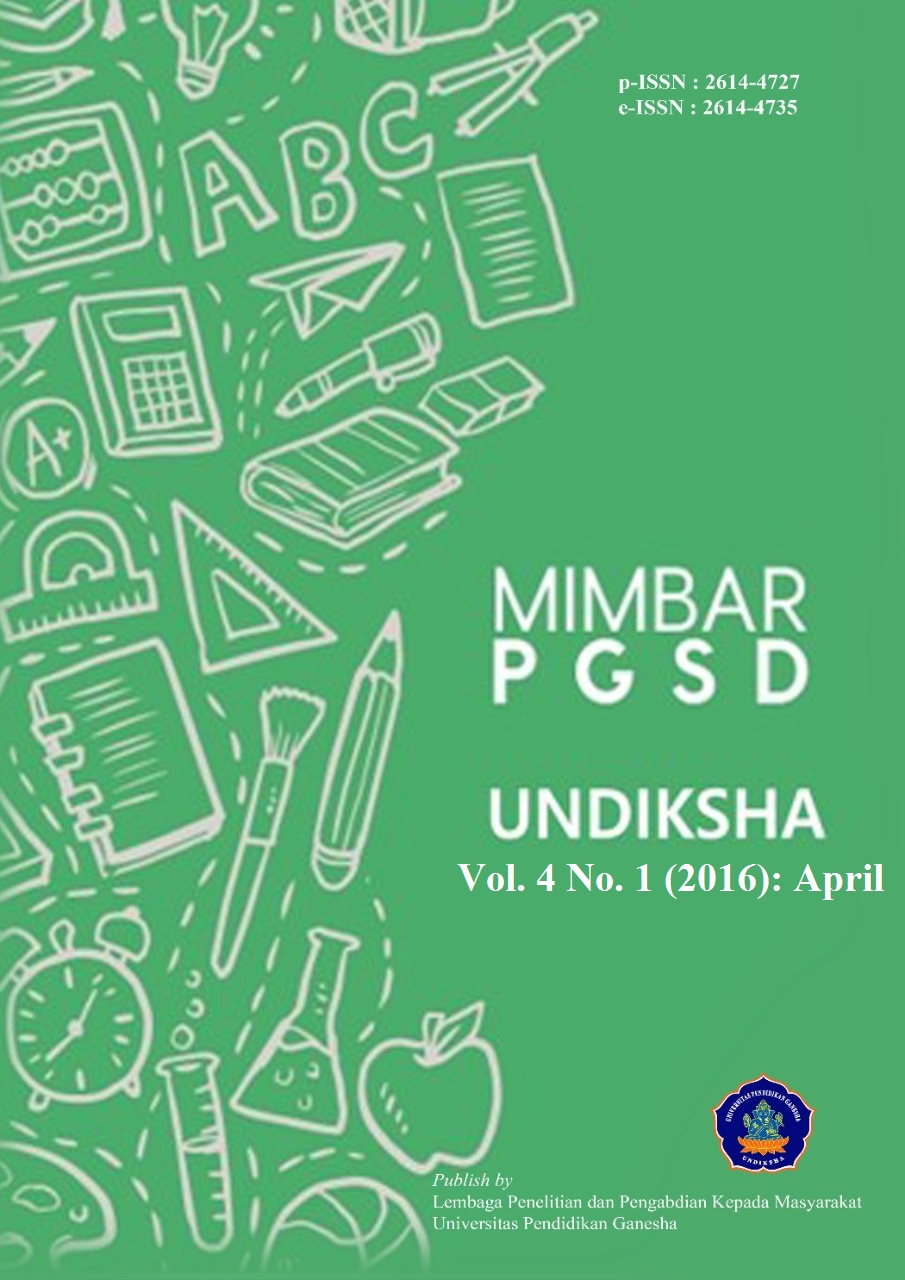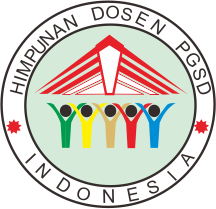PEMANFAATAN INSTRUMEN MUSIK TRADISIONAL BALI UNTUK MENINGKATKAN KEAKTIFAN DAN HASIL BELAJAR DALAM PEMBELAJARAN BERNYANYI
DOI:
https://doi.org/10.23887/jjpgsd.v4i1.7355Abstract
Penelitian in bertujuan untuk mengetahui ada tidaknya peningkatan aktivitas belajar peserta didik saat pembelajaran bernyanyi dan ada tidaknya peningkatan hasil belajar setelah pemanfaatan instrumen musik tradisional Bali dalam pembelajaran bernyanyi pada mata pelajaran Seni Budaya dan Keterampilan kelas V semester II tahun pelajaran 2015/2016 di SD Negeri 2 Banjar Tegal. Penelitian ini adalah penelitian tindakan kelas. Subjek penelitian adalah peserta didik kelas V SD Negeri 2 Banjar Tegal yang berjumlah 18 orang. Pengumpulan data dalam penelitian ini dilakukan dengan metode observasi dan tes. Data yang diperoleh dianalisis dengan metode analisis statistik deskriptif dan metode analisis deskriptif kualitatif. Hasil penelitian menunjukkan bahwa (1) pemanfaatan instrumen musik tradisional Bali dapat meningkatkan keaktifan belajar dalam pembelajaran bernyanyi pada mata pelajaran SBK di kelas V SD Negeri 2 Banjar Tegal. Rata-rata keaktifan belajar pada siklus I sebesar 76,78, pada siklus II sebesar 81,67, besar peningkatan adalah 4,89, (2) pemanfaatan instrumen musik tradisional Bali dapat meningkatkan hasil belajar dalam pembelajaran bernyanyi pada mata pelajaran SBK di kelas V SD Negeri 2 Banjar Tegal. Rata-rata hasil belajar pada siklus I mencapai 77,33 dan pada siklus II mencapai 83,11, mengalami peningkatan sebesar 5,78.Kata Kunci : instrumen musik, keaktifan belajar, hasil belajar
The research has a purpose to know wheter the student improve their activiness or not in learning singing subject and whether there is the increase of study result (psychomotor) or not after utilizing of Balinese traditional music instrument in teaching singing in art, culture, and skill subject in V grade in second semester on 2015/2016 at SD Negeri 2 Banjar Tegal. This research is action research. The subject of this research is the student in V grade at SD Negeri 2 Banjar Tegal. There are 18 observation and test then is analyzed by descriptive statistic analysis method and descriptive qualitative method. The results showed that (1) the use of traditional Balinese musical instruments can enhance the activity of learning in learning to sing on the subjects SBK class V SD Negeri 2 Banjar Tegal. The average activity of learning in the first cycle reaches 76.78 and the second cycle reaches 81,67, an increase of 4,89, (2) the use of traditional musical instruments of Bali can improve learning outcomes in learning to sing on the subjects SBK class V SD Negeri 2 Banjar Tegal. The average results of study in the first cycle reaches 77,33 and the second cycle reaches 83,11, an increase of 5,78.
keyword : instrument music, study activiness, study result
Published
2016-07-12
How to Cite
., G. P. S., ., D. I. I. W. S., & ., D. M. S. M. (2016). PEMANFAATAN INSTRUMEN MUSIK TRADISIONAL BALI UNTUK MENINGKATKAN KEAKTIFAN DAN HASIL BELAJAR DALAM PEMBELAJARAN BERNYANYI . MIMBAR PGSD Undiksha, 4(1). https://doi.org/10.23887/jjpgsd.v4i1.7355
Issue
Section
Articles
License
Authors who publish with the Mimbar PGSD Undiksha agree to the following terms:
- Authors retain copyright and grant the journal the right of first publication with the work simultaneously licensed under a Creative Commons Attribution License (CC BY-SA 4.0) that allows others to share the work with an acknowledgment of the work's authorship and initial publication in this journal.
- Authors are able to enter into separate, additional contractual arrangements for the non-exclusive distribution of the journal's published version of the work (e.g., post it to an institutional repository or publish it in a book), with an acknowledgment of its initial publication in this journal.
- Authors are permitted and encouraged to post their work online (e.g., in institutional repositories or on their website) prior to and during the submission process, as it can lead to productive exchanges, as well as earlier and greater citation of published work. (See The Effect of Open Access)













